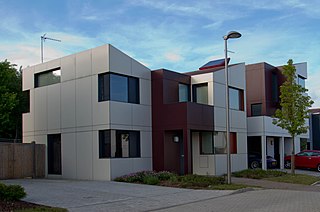
Barratt Developments plc is one of the largest residential property development companies in the United Kingdom operating across England, Wales and Scotland. It was founded in 1958 as Greensitt Bros., but control was later assumed by Sir Lawrie Barratt. It was originally based in Newcastle upon Tyne but is now located at David Wilson's former offices in Coalville, Leicestershire. It has been listed on the London Stock Exchange since 1968, and is a constituent of the FTSE 100 Index.
Vistry Group, formerly Bovis Homes Group, is a British house-building company based in Kings Hill, England. It is listed on the London Stock Exchange and is a constituent of the FTSE 250 Index.
Persimmon plc is a British housebuilding company, headquartered in York, England. The company is named after a horse which won the 1896 Derby and St. Leger for the Prince of Wales. It is listed on the London Stock Exchange and is a constituent of the FTSE 100 Index.
John Laing Group plc is a British investor, developer and operator of privately financed, public sector infrastructure projects such as roads, railways, hospitals and schools through Public-Private Partnership (PPP) and Private Finance Initiative (PFI) arrangements. It was listed on the London Stock Exchange and was a constituent of the FTSE 250 Index until the court approved the acquisition of the company by KKR in September 2021.

Alfred McAlpine plc was a British construction firm headquartered in Hooton, Cheshire. It was a major road builder, and constructed over 10% of Britain's motorways, including the M6 Toll. It was listed on the London Stock Exchange until it was acquired by Carillion in 2008.

Taylor Woodrow was one of the largest housebuilding and general construction companies in Britain. It was listed on the London Stock Exchange and was a constituent of the FTSE 100 Index until its merger with rival George Wimpey to create Taylor Wimpey on 3 July 2007.

Bryant Homes was one of the larger UK housebuilders when it was acquired by Taylor Woodrow in 2001; Bryant then became the principal housebuilding operation of the enlarged group. Taylor Woodrow merged with Wimpey in 2007 and during 2010 the Bryant brand was phased out. The company was first listed on the London Stock Exchange in 1962.
Tarmac Group Limited was a British building materials company headquartered in Wolverhampton, United Kingdom. It produced road surfacing and heavy building materials including aggregates, concrete, cement and lime, as well as operating as a road construction and maintenance subcontractor.

Taylor Wimpey plc is one of the largest home construction companies in the United Kingdom.

Taylor Woodrow Construction is a UK-based civil engineering contractor and one of four operating divisions of Vinci Construction UK. The business was launched in 2011, combining civil engineering operations from the former Taylor Woodrow group and from Vinci UK - formerly Norwest Holst.
Taylor Morrison is one of the largest home building companies in the United States. Its corporate headquarters are in Scottsdale, Arizona.
Leonard Fairclough & Son Ltd was a construction firm based in Adlington, Lancashire, England.
Countryside Partnerships plc, formerly Countryside Properties plc, is a UK housebuilding and urban regeneration company, operating mainly in London and the South East of England, but with a presence in the North West of England. It is listed on the London Stock Exchange and is a constituent of the FTSE 250 Index.
McLean Homes was a major British housebuilding business.
Miller Homes is a housebuilder based in the United Kingdom. It was founded in 1934, as part of the previous Miller Group. Its corporate headquarters is in Edinburgh, Scotland. Since its inception, Miller Homes has built over 100,000 homes.
Henry Boot PLC is a British property development business, listed on the London Stock Exchange. It was floated on the London Stock Exchange in 1919, becoming the first quoted housebuilder. Between the wars, Henry Boot built more houses than any other company.
Beazer was a family business for six generations before expanding in the 1980s into international housebuilding, construction and building materials group. After becoming overburdened with debt it was rescued by Hanson plc in 1991. A new Beazer Group, comprising solely the UK housebuilding business, was demerged from Hanson in 1994, and bought by Persimmon plc in 2001.
Ideal Homes was a British housebuilder.

Oxley Woods is a housing development in Oxley Park, a district of Milton Keynes, Buckinghamshire, England. The development was designed by Rogers Stirk Harbour + Partners and built by Newton Woods, who were subcontracted by Taylor Wimpey after winning the Office of the Deputy Prime Minister's Design for Manufacture Competition, which was run by English Partnerships in 2005.
Sir Joseph Anthony Dwyer was a British civil engineer and businessman. He joined Wimpey in 1955 and spent 44 years with the firm, becoming chief executive officer and chairman. Dwyer was responsible for repositioning Wimpey as a housebuilder by swapping its contracting arm for Tarmac's housing division. Wimpey subsequently saw a 30-fold increase in pre-tax profits. Dwyer served as chairman of the British part of TransManche Link, which built the Channel Tunnel and, after his 1999 retirement from Wimpey, served as president of the Institution of Civil Engineers. In the early 2000s he was chairman of the Liverpool Vision urban regeneration company and oversaw £2 billion of capital investment in regeneration projects including refurbishments of Lime Street station and King's Dock and construction of Liverpool Arena. Dwyer was appointed a deputy lieutenant of Merseyside in 2008 and a non-executive director of Cross London Rail Links in the same year.










